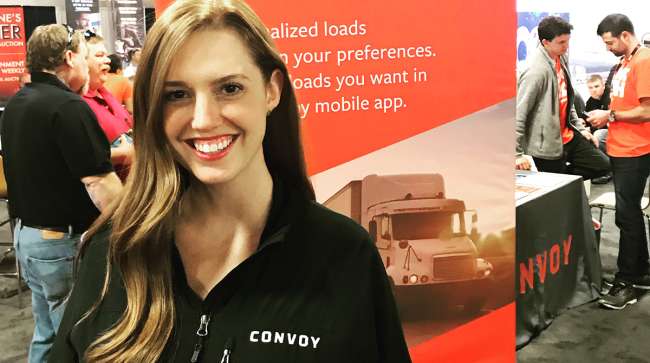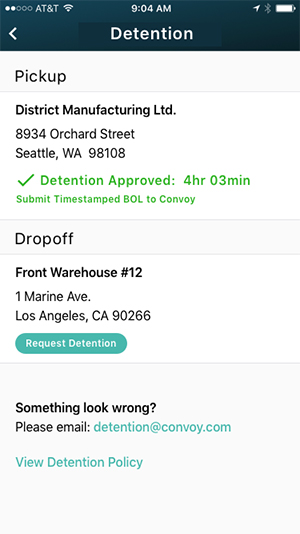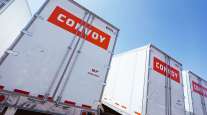Managing Editor, Features and Multimedia
Convoy Takes Aim at Driver Detention, Expands Connected Freight Network

LOUISVILLE, Ky. — Digital freight broker Convoy is taking action to mitigate a top frustration for truck drivers — excessive wait times at shipper and consignee facilities — as it continues to expand its network of connected carriers and shippers.
Rather than fighting to collect payment for detention time, drivers who book loads through Convoy’s mobile application now can use a new “automated detention” feature to request that pay directly in the app after sitting more than two hours at a customer location.
“We don’t think anyone should have to wait more than two hours at a facility, so we’re going to compensate you for that time,” said Kristen Forecki, vice president of operations at Convoy.
Convoy automatically calculates the time a truck has been sitting at a location through GPS tracking and geofencing. After the driver’s wait time reaches two hours, Convoy provides detention pay at a rate of $40 per hour, she said.
This process eliminates the hassle of making phone calls to traditional freight brokers or shippers to secure that detention payment, Forecki said in an interview with Transport Topics here March 23 at the Mid-America Trucking Show, where Convoy was exhibiting for the first time.
“We want to make sure that they know that they’re going to be fairly compensated if they have to wait,” she said. “We will pay regardless of whether the shipper pays.”
Convoy also is attacking the detention problem from the other side of the transaction by working with shippers to help them improve their operations.
“The shippers don’t like detention either. Everyone would be happy if it just went away,” she said. “Shippers are really trying to minimize it in their networks, and we can help with that because we have data that they’ve never seen before.”
Convoy can tell shippers how their different facilities are performing and how they compare with similar locations outside their networks.
That information might, for example, show a shipper that out of 20 facilities, there are two with high wait times and low driver ratings that are driving all of the company’s detention times.
By addressing those wait times, shippers can attract more carriers and reduce their own transportation costs, Forecki said.

Convoy
“It helps shippers understand why they may have more limited capacity or higher prices for those facilities,” she said. “Shippers want to be a shipper of choice now.”
Forecki also provided an update on Convoy’s progress toward its goal of “building the largest network of technology-connected trucks in the world.”
The Seattle-based company, founded in 2015, began by focusing on West Coast shipments, but now has expanded to a nationwide operation that offers carriers loads from coast to coast.
Today, more than 100,000 trucks and drivers are hauling freight in Convoy’s network, the company said.
More than 350 shippers are using the platform, ranging from major shippers such as Anheuser-Busch and Unilever to small companies that might ship only a single load per month. Convoy now counts more than 20 Fortune 500 companies among its shipper customers, compared with less than a handful a year ago.
Convoy’s freight network is designed to reduce waste in the supply chain by matching carriers with the kinds of loads that fit their needs.
Other technology firms offering similar freight matching services include Uber Freight and Transfix.
In addition to automated detention, Convoy also has expanded its platform with “request a load” and “suggested reloads” features, both of which are designed to help carriers better manage their limited time under federal hours-of-service limits.
“Especially with [electronic logging devices] in the market now, this has been a really big concern for our carriers, and we’ve been hearing this from drivers for a long time,” Forecki said.
She mentioned one driver who compared the job to “living in an episode of ‘24,’” with the constant pressure of a ticking clock.
Dispatchers using the “request a load” feature can tell Convoy when and where their trucks will be empty and where they want to go next. Convoy then sends alerts as loads that match those criteria become available.
And with “suggested reloads,” Convoy provides recommended reloads near the carrier’s drop-off location.
Both features are designed to help carriers find their next load more quickly, reducing empty miles and the amount of time spent finding another load.
Separately, Convoy also has begun offering tire discounts and roadside assistance to its carriers through a partnership with Goodyear Tire & Rubber Co.
By showing the Convoy app to a salesperson, carriers can qualify for 20-45% off all Goodyear, Goodyear Marathon and Dunlop brand tires and retreads.
Carriers also can access Goodyear’s Fleet HQ roadside service while hauling a Convoy load by calling the Convoy support line.






